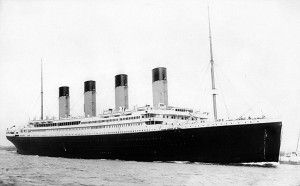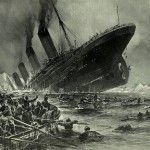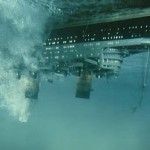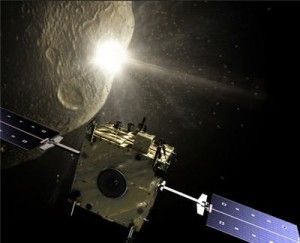This essay was posted previously last year and removed and has appeared in abridged form in the European Space Safety online Magazine and can also be found on Yahoo voices.
Several dates are cited as marking the beginning of the space age. Sputnik, October 4th, 1957, Yuri’s day April 12th, 1961, and the first successful V-2 launch by the Nazis on October 3rd, 1942, to name a few. Some prefer December 21st, 1968, when human beings first escaped the Earth’s gravitational field on Apollo 8. When studying the events that allowed man to leave Earth, future historians may agree on a date not generally associated with space flight. July 16th, 1945 was Trinity, the first nuclear weapon test. Stanislaw Ulam, a 36-year-old Polish mathematician who helped build “the gadget”, visited ground zero after the test. Ulam later conceived the idea of propelling a spaceship with atomic bombs. Near the end of his life the eccentric genius stated the idea was his greatest work.
When considering nuclear propulsion, it must be understood that space is not an ocean, though often characterized as one. The distances and conditions are not comparable. While chemical energy has allowed humankind to travel across and above the surface of Earth, the energy required to travel in space is of a different order. Water, in the form of steam, was the agent of change that brought about the industrial revolution. Fossil fuel, burned and transformed by steam into mechanical work, would radically change the world in the span of a century. What is difficult for moderns to understand is not only how limited human capabilities were before steam, but how limited they are in the present in terms of space travel. The psychological limits of human beings limit space journeys to a few years. Chemical propulsion is not capable of taking human beings to the outer solar system and back within those crew limits. The solution is a reaction one million times more powerful. Nuclear energy is to the space age as steam was to the industrial age.
Space is not an ocean and this was the correct lesson drawn by Stanislaw Ulam after that suddenly bright morning in 1945. While metal can barely contain and harness chemical energy, Ulam thought outside that box and accepted nuclear energy could never be contained efficiently by any material. However, nuclear energy could be harnessed to push a spaceship in separate events to the fantastic velocities required for interplanetary travel without any containment problems at all- by using bombs. An uncontained burst of nuclear generated plasma could be withstood by a surface momentarily before the physical matter had time to melt.
Sixty years after Ulam’s stroke of genius, atomic bomb propulsion still has no competition as the only available propulsion system for practical interplanetary travel. This fact is almost completely unknown to the public. The term “ISP”, expressed in seconds, is used in measuring the efficiency of a rocket engine and chemical rockets have low ISP numbers but high thrust. The most efficient rocket engines, such as the space shuttle main engines, with a listed ISP of 453 seconds are also among the most powerful. Atomic bomb propulsion, thanks to the billions of dollars poured into star wars weapons research, would have an ISP exceeding 100,000 seconds. While other propulsion systems that use electricity have similar or higher numbers, the amount of thrust is trivial and requires months or years of continuous operation to develop any significant velocity. Considering space travel as not only a speed and distance problem, but also a time and distance problem, low thrust lengthens any missions to the outer solar system beyond crew limits. The thrust imparted by atomic bombs can in a short period easily accelerate thousands of tons to the comparatively extreme speeds necessary and then coast. Unlike an electric propulsion failure, a few dud bombs need not doom a mission or crew.
Though an incredible use of awesome power, the obstacles to employing bomb propulsion are not technical as some of the best engineers and physicists on the planet evaluated and validated the concept. A cadre of celebrity scientists also endorsed atomic bomb propulsion, including Werner Von Braun, who was present as a Nazi SS officer at the first successful V-2 launch, and as an American citizen at the launch of Apollo 8. Arthur C. Clarke and Carl Sagan were also supporters. The first serious work on bomb propulsion was done by physicist Freeman Dyson and weapon designer Ted Taylor on the top secret project Orion. Dyson’s son, in his book Project Orion, refers to the classified star wars project Casaba Howitzer. This device focused most of the energy of a nuclear explosion in one direction. Ted Taylor’s specialty was small warheads and he designed the Orion bombs, aka “pulse units.” The “unclassified” state of the art in nuclear weapons can direct 80 percent of bomb energy into a slab of propellant, converting this mass into a jet of superheated plasma. A pusher plate would absorb the blast without melting for the fraction of a second it lasts and accelerate the spaceship in steps with each bomb. Perhaps the closest experience to riding in an atomic bomb propelled spaceship would be repeated aircraft carrier catapult launches. Instead of the ocean- space, instead of supersonic fighters- a thousand ton spaceship.
Project Orion was canceled due to nuclear weapon treaties requiring international consent for using any such devices in space. A parallel to the failure of atomic bomb propulsion may be found in an examination of the industrial age. In The Most Powerful Idea in the World: A Story of Steam, Industry, and Invention, author William Rosen theorizes English patent law was the key enabler of the industrial age by allowing inventors to retain and profit from their intellectual property. The atomic bomb originated with a letter to President Roosevelt in 1939 from pacifist Albert Einstein- who was afraid the Nazi’s might build one first. With the human race living at the bottom of a deep, damp, and easily contaminated gravity well, atom bombs have never been applied successfully to a peaceful purpose. Stan Ulam, who lost most of his family in the holocaust, held the patent on atomic bomb propulsion. In the space age, nuclear weapon treaties and anti-nuclear activism have had the opposite effect of patent law and prevented atomic bomb propulsion from opening up the solar system to human exploration and colonization. Ironically, the nuclear industry is not safe on Earth- but deep space seems designed for it. There are no contamination or waste hazards, no long-term storage problems.
The problems with space travel are more than just the political barriers to detonating nuclear devices. The space industry is ipso facto a nuclear industry. Not only is nuclear energy the only practical source of propulsion in deep space, nuclear radiation generated by supernova and other celestial sources permeate space outside the protection of the earth’s atmosphere. All astronauts are radiation workers. Most, but sadly not all, space radiation is relatively easy to shield against. Many will argue using atomic bombs for propulsion is unnecessary. The presence of a small percentage of highly damaging and deeply penetrating particles- the heavy nuclei component of galactic cosmic rays makes a super powerful propulsion system mandatory. The tremendous power of atomic bomb propulsion is certainly able to propel the heavily shielded capsules required to protect space travelers. The great mass of shielding makes chemical engines, inefficient nuclear thermal rockets, the low thrust forms of electrical propulsion, and solar sails essentially worthless for human deep space flight. Which is why atomic bomb propulsion is left as the only “off the shelf” viable means of propulsion. For the foreseeable future, high thrust and high ISP to propel heavy shielding to the required velocities is only possible using bombs. The most useful and available form of radiation shielding is water. While space may not be an ocean, it appears human beings will have to take some of the ocean with them to survive.
The water comes before the bombs in human space flight because of the humans. The radiation hazards of long duration human space flight beyond earth orbit are only recently being addressed after decades of space station experience. The reason for this neglect is low earth orbit space stations are shielded from much of the radiation found outside the Earth’s Van Allen belts and magnetic field. An appreciation of the heavy nuclei component of galactic cosmic radiation, as well as solar events, will put multi-year human missions beyond earth orbit on hold indefinitely until a practical shield is available. While vested interests continue to promote inferior or non-existent technology, dismissing the radiation hazards and making promises they cannot keep, radiation scientists studying deep space conditions are skeptical- to say the least.
In the March 2006 issue of Scientific American magazine, Dr. Eugene Parker explained in simple terms survivable deep space travel. In “Shielding Space Travelers”, Parker states, “cosmic rays pose irreducible risks.” The premise of this statement is revealed when the only guaranteed solution to reducing the risk- a shield massing hundreds of tons- is deemed impractical. Active magnetic shields and other schemes are likewise of no use because while they may stop most radiation, the only effective barrier to heavy nuclei is mass and distance. The impracticality of a massive shield is due to first the expense of lifting hundreds of tons of shielding into space from Earth, and secondly propelling this mass around the solar system. Propelling this mass is not a problem if using atomic bombs, however, another problem arises. Even if the bombs could be politically managed, there is still the need to escape Earth’s gravitational field with all that shielding. Bomb propulsion is ideal for deep space but cannot be used in Earth orbit due to the Earth’s magnetic field trapping radioactive fallout that eventually enters the atmosphere. Not only lifting the shielding into orbit but chemically boosting it to a higher escape velocity away from the Earth is thus doubly problematic. Earth is a deep gravity well to climb out of.
The situation changed in March 2010 when NASA reported Mini-SAR radar aboard the Chandrayaan-1 lunar space probe had detected what appeared to be ice deposits at the lunar North Pole. An estimated 600 million tons of ice in sheets a couple meters thick. Moon water would allow a spaceship in lunar orbit to fill an outer hull with the 500+ tons of water required to effectively shield a capsule from heavy nuclei. This would enable an empty spaceship to “travel light” to the Moon and then boost out of lunar orbit using atomic bomb propulsion with a full radiation shield. Parker’s guaranteed but impractical solution had suddenly become practical. Fourteen feet of water equals the protection of the Earth’s air column at an altitude of 18,000 feet above sea level. This would protect astronauts not only from all forms of cosmic radiation but the most intense solar storms and the radiation belts found near the moons of Jupiter. With water and bombs, epic missions of exploration to the asteroid belt and outer planets are entirely possible. The main obstacles are again political, not technical. Bombs work, water works, and the Moon is in range of chemically propelled spacecraft launched from Earth.
There are other challenges to long duration beyond earth orbit human space flight but the solutions have been known for many decades. Zero gravity debilitation causes astronauts to weaken and permanently lose bone and bone marrow mass. The most practical solution, theorized since the early 1930′s, was investigated in 1966 during the Gemini 11 mission. A 100-foot tether experiment with the capsule attached to an Agena booster was successful in generating a small amount of artificial gravity by spinning the two vehicles. Equal masses on the ends of a tether can efficiently generate centrifugal force equal to one gravity. The concept is to “split the ship” when not maneuvering under power so the 500+ tons of shielded capsule is on one end and the rest of the craft of equal mass is reeled out on the other end of a thousand foot or more tether. Looking out through 14 feet of water, the crew of such a spaceship would view a slowly rotating star field. Long duration missions may last close to half a decade and the only option for providing air and water is to use a miniature version of Earth’s ecosystem. Equipment to enable a closed cycle life support system providing years of air and water is now available in the form of plasma reformers and facilitated by tons of water in which to grow algae or genetically modified organisms. With Earth radiation, Earth gravity, and air and water endlessly purified on board, crews can push their psychological limits as many years and as far out into the solar system as the speed of their atomic spaceships allow.
At the time of this writing, in early 2011, the outlook for human space flight is not encouraging. There are zero prospects for funding a long duration beyond earth orbit mission. Using atomic bombs to push minimum spaceship masses of over one thousand tons around the solar system for years at a time would cost as much as several major U.S. department of defense projects combined. Space flight is inherently expensive; there is no cheap. However, there is a completely valid military mission for atomic bomb propelled spaceships. Planetary protection became an issue in 1980 after the Chicxulub impact crater in Mexico was assigned blame for the mass extinction of the dinosaurs. Though overshadowed by the cold war, the impact threat remains. Comet and asteroid impacts are also the stuff of Hollywood movies and this is unfortunate in that a grave threat to the survival of life on earth is viewed as fictional entertainment. The impact threat is not science fiction; it is quite real, as the frequent near misses and geologic evidence of repeated extinction events show. Optimized directional bombs used in bomb propulsion could also be employed to deflect comets and asteroids long before they approach Earth.
While the consequences of ignoring the threat of an inevitable tsunami, earthquake, or hurricane are bad, the consequences of ignoring the inevitable comet or asteroid impact are apocalyptic. It is not only random impacts that could strike at any time the human race need guard against. In April of 2010 renowned physicist Stephen Hawking warned of alien civilizations posing a possible threat to humanity. Several large comets purposely crashed into a planet to wipe out the majority of indigenous life and prepare for the introduction of invasive alien species may be a common occurrence in the galaxy. Before readers scoff, they might consider towers brought down by jetliners, the discovery of millions of planets, and other recent unlikely events. It is within our power to defend Earth from the very real threat of an impact, and at this time self-defense is the only valid reason to go into space instead of spending the resources on Earth improving the human condition. Protecting our species from extinction is the penultimate moral high ground above all other calls on public funds. The vast treasure expended by nations threatening each other is not protecting the human race at all. Earth is defenseless. President Ronald Reagan in his 1983 Star Wars speech said, “I call upon the scientific community who gave us nuclear weapons to turn their great talents to the cause of mankind and world peace.” President Barack Obama has expressed a desire to reduce the world nuclear arsenal and converting these weapons to propulsion devices would do so. A powerful force of nuclear powered, propelled, and armed spaceships cannot guarantee Earth will not suffer a catastrophe. The best insurance for our species is to establish, in concert with a spaceship fleet, several independent self-supporting off world colonies in the outer solar system. The first such colony would mark the beginning of a new age.
Time line
1939 (August) Einstein sends letter recommending atomic bomb.
1939 (September) Germany invades Poland, World War 2 begins.
1942 First successful V-2 rocket launch by the Nazis.
1945 Trinity, the first atomic bomb is detonated.
1957 Sputnik achieves orbit using a rocket designed to carry an atomic bomb.
1961 Yuri Gagarin orbits Earth.
1966 Gemini 11 mission demonstrates artificial gravity.
1967 Outer Space Treaty restricts nuclear weapons in space.
1968 Apollo 8 crew escapes Earth’s gravitational field.
1980 Chicxulub impact crater revealed as dinosaur killer.
1983 Ronald Reagan gives Star Wars speech.
2006 Eugene Parker explains survivable deep space travel.
2010 (March) Millions of tons of ice are discovered on the Moon.
2010 (April) Stephen Hawking warns of alien civilization threat.
References
George Dyson, 2002, Project Orion: The True story of the Atomic Spaceship, Henry Holt and Company, LLC
Eugene Parker, March 2006, Shielding Space Travelers, Scientific American Magazine
William Rosen, 2010, The Most Powerful Idea in the World: A Story of Steam, Industry, and Invention, Random House







